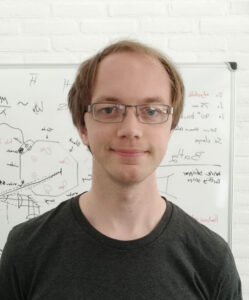Antimatter falls down exactly like matter, the Alpha-g experiment at CERN shows. Nikhef researcher in Groningen Steve Jones was involved in the measurements.
It’s a physical result that captures the imagination, and so newspapers and other media have been full of news about falling antimatter since Wednesday. Nature publishes the first results from Alpha-g, an experiment at CERN that studies whether anti-matter falls differently than matter. The short answer: no, exactly the same.

Physicist Steve Jones of the Van Swinderen laboratory in Groningen, a partner of Nikhef, is one of the seventy authors of the Nature article. He is not surprised by all the public attention. “It’s a nice clear result. The question is does antimatter fall down or up. Down, that is.”
Antimatter itself is a common phenomenon in the particle world. In collision experiments, most charged elementary particles have a double with exactly the opposite charge and otherwise identical properties such as mass.
Many experiments do try to find small fundamental differences. Theoretically at least, there is hardly any reason to think that they would respond differently to gravity, than ordinary matter.
But to be the first to measure that directly is still very special, Jones says.
Steve Jones came to Groningen last year but before that spent 10 years attached to Alpha Experiment at CERN, which makes and studies anti-hydrogen. Hydrogen atoms consist of a proton and an electron. Anti-hydrogen atoms consist of an anti-proton and an anti-electron. CERN has an entire complex to make the antiparticles and bring them together.
Jones helped build the setup for this measurement for years and was one of the experimenters. He fondly remembers the moment the result became clear. “We saw the data coming in and were extremely pleased with the quality of the measurements. Of course, a few people were still a bit disappointed that antimatter does not fall upward. That would have been something.”
The now-published result still has limited accuracy. Good enough, Jones says, to rule out antimatter falling upward. But measuring how it does fall could be more precise. “The current measurements use only the trap in which antihydrogen is produced. We can shuffle the antihydrogen atoms to another part of our experiment where we have better control over the magnetic fields.”
In Groningen, Jones is working on a new technique that allows measurements of hydrogen and antihydrogen to be made simultaneously under identical conditions. “This eliminates all systematic errors,” Jones says. Precision below the one percent level then becomes possible.
The Groningen work involves a proof of principle. Eventually, his hydrogen anti-hydrogen confinement device should be used again at CERN, where anti-hydrogen is actually available. That moment is still about five years away, he thinks.
The main problem, Jones explains of his technique, is that experiments with hydrogen and antihydrogen must take place under extreme vacuum. After all, the chances of the antipodes encountering each other in the system must be minimal. Otherwise, the antiparticles will annihilate against the background gas.
Jones: “Anti-hydrogen is extremely rare, you hardly have any atoms of it. But ordinary sources for hydrogen give far too many atoms and nullify the vacuum. We are looking for a technique to pull ultracold molecules apart with a laser, so that you have just enough hydrogen atoms, but no more.”
Jones’ work touches on the eEDM experiments happening in Groningen under the Nikhef banner, which measure extremely precisely whether electrons could possibly be slightly asymmetric. These also involve working with cold molecules and confinement in ion traps such as those Jones also uses. “The interface between molecular physics and fundamental particle physics is growing rapidly,” he notes.